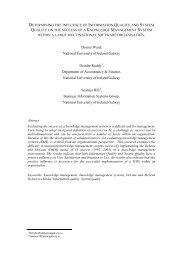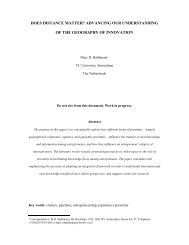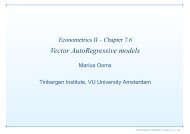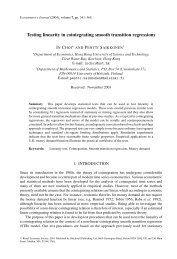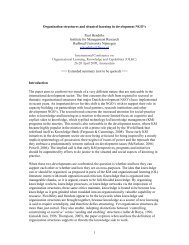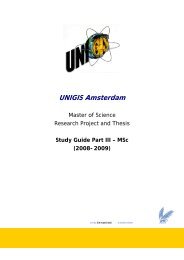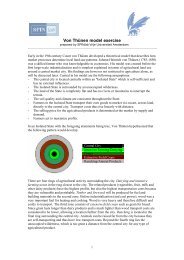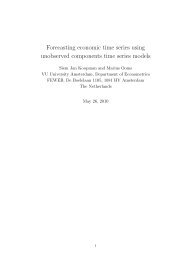Pinar Karaca-Mandic and Kenneth Train, (2003), pp. 400 ... - Feweb
Pinar Karaca-Mandic and Kenneth Train, (2003), pp. 400 ... - Feweb
Pinar Karaca-Mandic and Kenneth Train, (2003), pp. 400 ... - Feweb
You also want an ePaper? Increase the reach of your titles
YUMPU automatically turns print PDFs into web optimized ePapers that Google loves.
St<strong>and</strong>ard error correction in two-stage estimation with nested samples 403<br />
<strong>and</strong> Topel (1985) result for an a<strong>pp</strong>lication in which the correlation in the r<strong>and</strong>om components<br />
of the first <strong>and</strong> second steps take a particular form due to the nested structure of the data. Note<br />
that if there is no error in the first stage (i.e. hm(θ ∗ 1 ) = 0 ∀m), then this formula for the asymptotic<br />
covariance becomes the robust covariance estimator of ˆθ2 that allows for correlation over<br />
observations within each market. 2 Also note that these formulae assume that N1 → ∞, though<br />
Var(Xm) will decline as N2 increases as well.<br />
3. APPLICATION<br />
We adapt <strong>and</strong> a<strong>pp</strong>ly the formula to the model of Petrin <strong>and</strong> <strong>Train</strong> (2002). Their model is a mixed<br />
logit of choice at the consumer level that uses an explanatory variable that is estimated by regression<br />
on market level data. They examine customers’ choice of TV reception, with the alternatives<br />
being: antenna only, cable with basic or extended service, cable with premium packages, or satellite.<br />
Each customer lives in a franchise area, called a market, <strong>and</strong> the price <strong>and</strong> other attributes<br />
of the alternatives vary over markets. Some attributes of the alternatives, such as quality of programming,<br />
are not measurable <strong>and</strong> hence not included as explanatory variables in the customer<br />
choice model. Since the omitted attributes are expected to be related to price, their omission<br />
induces correlation between the unobserved portion of utility <strong>and</strong> price. One of the ways they<br />
address this correlation is through a control function a<strong>pp</strong>roach; in particular, they regress market<br />
price against market-level instruments <strong>and</strong> then enter the residual of this price regression as an<br />
explanatory variable in the customer-level choice model. Unobserved utility conditional on this<br />
price residual need not be correlated with price; the density of this conditional unobserved utility<br />
determines the form of the choice model.<br />
The model is specified as follows. The first stage consists of OLS a<strong>pp</strong>lied to linear<br />
regressions:<br />
pmj = β ′ j zm + µmj,<br />
where pmj is the price of alternative j in market m <strong>and</strong> zm are instruments. The estimated residuals<br />
ˆµmj = pmj − ˆβ ′ j zm are calculated. The utility that customer n who resides in market m<br />
obtains from alternative j is specified as<br />
Unmj = α ′ wnmj + λ jµmj + εnmj.<br />
The explanatory variables wnmj include the price <strong>and</strong> other observed attributes of alternative j<br />
in market m, interacted in some cases with demographics of the customer. In estimation, the ˆµmj<br />
is used in lieu of the true µmj. Petrin <strong>and</strong> <strong>Train</strong> assume that the error εnmj contains a component<br />
that is normally distributed <strong>and</strong> common to all non-antenna alternatives, plus an i.i.d. extreme<br />
value term. Their choice model is therefore a mixed logit, with mixing over the normal error<br />
component.<br />
The price of antenna only is zero for all customers, <strong>and</strong> the price of satellite does not vary<br />
over markets. Price regressions are therefore estimated only for the two cable alternatives, <strong>and</strong><br />
only the utility for these two alternatives includes price residuals. The two cable alternatives are<br />
denoted j = 2, 3.<br />
2 The robust covariance estimator is the ‘cluster’ estimator implemented by Rogers (1993) <strong>and</strong> marketed by Stata.<br />
c○ Royal Economic Society <strong>2003</strong>





